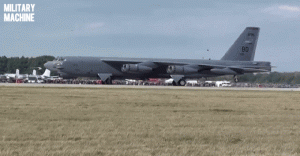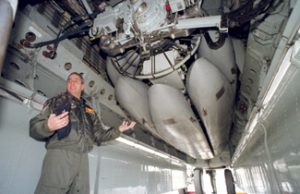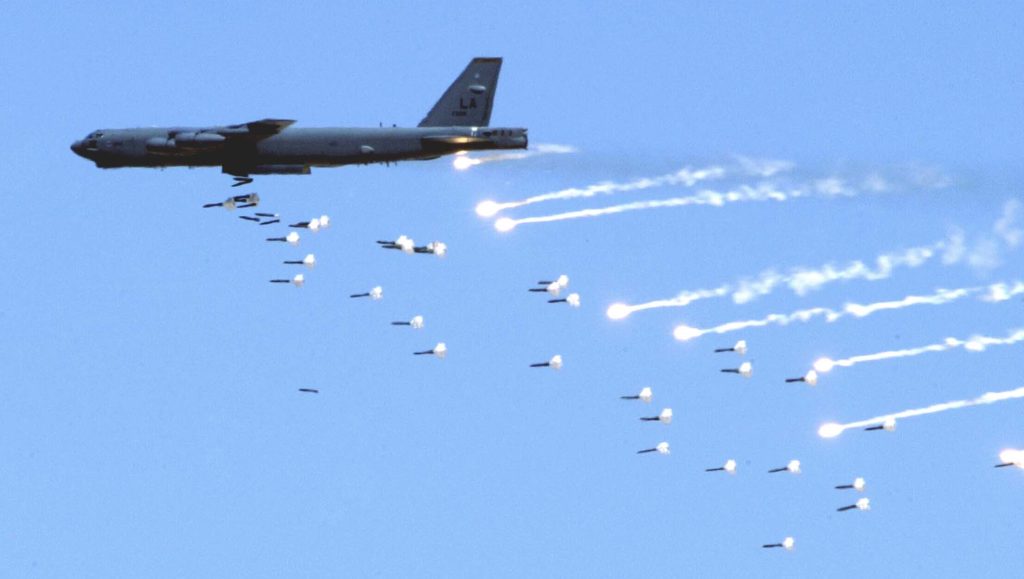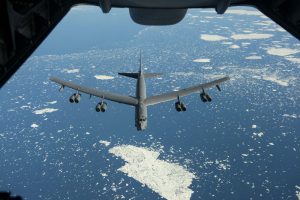B-52 Stratofortress Strategic Bomber – The BUFF
Boeing’s B-52 long-range strategic bomber is not only one of the most iconic symbols of the Cold War; it’s also the longest-serving combat aircraft in any major nation’s arsenal. Since 1952, the B-52 Stratofortresses, or “Big Ugly Fat Fellows” (BUFF’s) as crewmembers often call them, have served as the backbone of America’s nuclear deterrence and the workhorse for its conventional strike force.
 Performance:
Performance:
While costing $70,000 a flight hour to operate, $3,000 more than an F-35, B-52’s can haul four times the ordinance. Most importantly, they’re capable of flying over 8,000 miles without refueling before delivering all 35 tons of explosives on target. For lack of a cost-effective replacement, there’s little wonder the Pentagon plans to keep this living history museum operational well into the mid-21st century.

Nuclear Role:
The first B-52’s were delivered to the Strategic Air Command in 1961, where more than 100 bombers were immediately dispatched on their first real-world deployment as part of Operation Chrome Dome. This operation was no training exercise, but rather an eight-year continuous airborne alert during the height of the Cold War, which has been immortalized in several major Hollywood films.
At any given moment up until 1968, an entire squadron of combat-ready Stratofortresses, each armed with dozens of thermonuclear weapons, patrolled the skies towards their “control points” just outside the Soviet Union’s border. Their sole mission: respond massively at an instance’s notice to any nuclear first strike by the USSR.
While the bomber’s role as the “first and last” nuclear option was largely replaced by intercontinental ballistic missiles in the late 1960’s, many military historians credit the B-52 with maintaining a strategic balance of power and helping to ensure that the Cold War never turned hot during those early years of confrontation.

Vietnam Carpet Bombing:
When not serving as a crucial part of the US’s nuclear defense triad, B-52’s and their crews were deployed extensively throughout the Vietnam War. From their first official combat mission, Operation Rolling Thunder in 1965, until the final Arc Light bombing runs in 1972, Stratofortresses and their crews launched thousands of sorties against North Vietnam, as well as provided close air support to US ground forces fighting in South Vietnam. This heavy combat load came at a price though, with 31 bombers lost throughout the war—17 from combat action—and claimed almost 50 American lives.
Defenses:
Not that the massive bombers were completely helpless in the skies though. Thanks to radar-guided, quad-mounted .50 machine guns in the tail of each aircraft, B-52 gunners claimed three enemy air-to-air kills over Vietnam.

Persian Gulf War:
Operation Desert Storm in 1991 gave perhaps the most dramatic demonstration of the B-52’s “carpet bombing” power in the wide-open deserts of Kuwait and Southern Iraq. In that short conflict, Stratofortresses conducted over 1,600 sorties and delivered 40% of the total ordinance dropped by the US-led coalition on Iraqi forces.
Modern Close Air Support Role:
Despite the Cold War being a distant memory and the likelihood of a high-intensity conventional war requiring strategic bombing quite remote, the B-52 still has a vital role to play in US military operations. By replacing ordinance with GPS-guided precision strike weapons like JDAM’s, even combating insurgents in urban parts of Afghanistan and Iraq has become a routine mission for these heavy bombers.

The B-52’s massive strike range and eight-plus hour endurance on station, not to mention the bomber’s significant psychological shock value against enemy combatants, ensures these Eisenhower-era “BUFF’s” will remain for the foreseeable future indispensable to America’s defense and ultimately to world peace.
Now see more captivating images of the Stratofortress aircraft.
See B-52 Stratofortress Specifications
| Contractor: Boeing Military Airplane Co. |
| Power Plant: Eight Pratt & Whitney engines TF33-P-3/103 turbofan |
| Thrust: Each engine up to 17,000 pounds |
| Wingspan: 185 feet (56.4 meters) Length: 159 feet, 4 inches (48.5 meters) |
| Height: 40 feet, 8 inches (12.4 meters) |
| Weight: Approximately 185,000 pounds (83,250 kilograms) |
| Maximum Takeoff Weight: 488,000 pounds (219,600 kilograms) |
| Fuel Capacity: 312,197 pounds (141,610 kilograms) |
| Payload: 70,000 pounds (31,500 kilograms) |
| Speed: 650 miles per hour (Mach 0.84) |
| Range: 8,800 miles (7,652 nautical miles) |
| Ceiling: 50,000 feet (15,151.5 meters) |
| Armament: Approximately 70,000 pounds (31,500 kilograms) |
| Mixed Ordnance: Bombs, mines and missiles. (Modified to carry air-launched cruise missiles) |
| Crew: Five (aircraft commander, pilot, radar navigator, navigator and electronic warfare officer) |
| Unit Cost: $84 million (fiscal 2012 constant dollars) |
| Inventory: active force, 58; ANG, 0; Reserve, 18 (Oct. 2016) |
Watch The B-52 In Action

